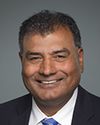Mr. Speaker, on May 1, 2020, the Government of Canada announced the immediate prohibition of over 1,500 models of assault-style firearms that are specifically designed for soldiers to shoot other soldiers. The prohibition limits access to the most dangerous firearms and removes them from the Canadian market.
For decades, police chiefs had been advocating for such a measure. In 1986, the Canadian Association of Chiefs of Police, CACP, declared there was a “worldwide surplus” of accessible firearms that were designed for warfare and for the federal government to “take the steps necessary to end this increase in available weapons.” In 1994, the CACP declared that “military assault rifles” were produced for the “sole purpose of killing people in large numbers” and urged the Minister of Justice to enact legislation to “ban all military assault rifles except for law enforcement and military purposes.” Last September, the Ontario Association of Chiefs of Police declared their support for a prohibition on all military-designed assault rifles. In their view, “these weapons have no place in our communities and should be reserved for use by Canada’s military and law enforcement.” Additionally, the current chief of the Canadian Association of Chiefs of Police has declared that this prohibition “finds balance” as it “ensures the safety of our members” while not limiting “those that recreationally participate in hunting or those that actually live off the land.”
Between October 2018 and February 2019, the government held extensive public engagement on the issue of banning handguns and assault-style firearms with the provinces and territories, municipalities, indigenous groups, law enforcement, community organizations and industry to help inform policy, regulations and legislation to reduce violent crime involving firearms. While the engagement was framed by the examination of a potential ban, the discussion explored several potential measures to reduce violent crime including enhanced enforcement capacity for law enforcement and border services, investments to support initiatives that reduce violence, and strengthening safe firearms storage requirements to help prevent theft. Many participants expressed that a ban on assault-style firearms was needed in order to protect public safety.
We put in place an amnesty to give existing owners time to come into compliance with the law. The amnesty order also provides a temporary exception for indigenous persons exercising section 35 constitutional rights to hunt and for sustenance hunters to allow for continued use of newly prohibited firearms, if previously non-restricted, until a suitable replacement can be found. The government remains committed to introducing a buyback program during the amnesty period. However, the costs associated with implementing a buyback program have not yet been finalized.
While the prohibition was a crucial initiative, it was only the first step in the government’s gun control agenda. The government also intends to bring forward targeted measures to further address the criminal use of firearms. We will strengthen firearms storage requirements to deter theft. Following hundreds of millions of dollars cut by the previous Conservative government, we will continue to make the necessary investments to enhance our tracing capacity and reduce the number of guns being smuggled across the border. We will continue to also work with our partners from other levels of government to develop an approach to address handguns.
The government also intends to build on previous investments in youth and community measures, because we know that better social conditions lead to a reduction in crime and violence.
These initiatives were identified as a priority by our government, both in the throne speech and in the Prime Minister’s mandate letter to the Minister of Public Safety and Emergency Preparedness and we are committed to addressing these important issues as soon as possible.










